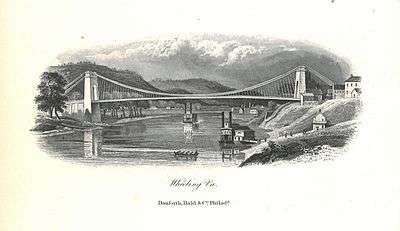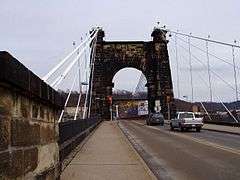Wheeling Suspension Bridge
| Wheeling Suspension Bridge | |
|---|---|
 View from the Wheeling Suspension Bridge, 1977. Photo taken from City of Wheeling side, looking West toward Wheeling Island. | |
| Carries |
|
| Crosses | main channel of the Ohio River |
| Locale | Wheeling, West Virginia |
| Characteristics | |
| Design |
suspension bridge originally: Gravity-anchored currently: cable-stayed[1] |
| Longest span | 308 meters (1,010 ft)[1] |
| History | |
| Designer |
original: Charles Ellet Jr. redesigner: Wilhelm Hildenbrand[1] |
| Construction begin | 1847[1] |
| Construction end | 1849, 1854, 1859, 1872[2] |
|
Wheeling Suspension Bridge | |
|
Photo taken from Wheeling Island side, looking East toward the City of Wheeling. | |
  | |
| Location | Wheeling, West Virginia |
| Coordinates | 40°4′12.58″N 80°43′38.46″W / 40.0701611°N 80.7273500°WCoordinates: 40°4′12.58″N 80°43′38.46″W / 40.0701611°N 80.7273500°W |
| Built | 1849 |
| Architect | Charles Ellet Jr.; Washington Roebling |
| Architectural style | Other |
| NRHP Reference # | 70000662 |
| Significant dates | |
| Added to NRHP | January 26, 1970[3] |
| Designated NHL | May 15, 1975[4] |
The Wheeling Suspension Bridge is a suspension bridge spanning the main channel of the Ohio River at Wheeling, West Virginia. It was the largest suspension bridge in the world from 1849 until 1851. It was designed by Charles Ellet Jr., who also worked on the Niagara Falls Suspension Bridge. The Wheeling bridge was the first to span the Ohio River, and was an important link on the National Road.
The main span is 1,010 feet (310 m) from tower to tower. The east tower rests on the Wheeling shore, while the west tower is on Wheeling Island. The east tower is 153.5 feet (46.8 m) above the low-water level of the river, or 82 feet (25 m) from the base of the masonry. The west tower is 132.75 feet (40.46 m) above low water, with 69 feet (21 m) of masonry.[5]
The Wheeling Suspension Bridge was designated a National Historic Landmark on May 15, 1975.[4] It is located in the Wheeling Island Historic District.[3]
History
A charter was granted to the Wheeling and Belmont Bridge Company in 1816 to construct a bridge to extend the Cumberland Pike, which was to be completed in 1818, to Ohio. After a number of delays, a new bridge charter was obtained in 1847. Charles Ellet and John A. Roebling were invited to submit designs and estimates for a bridge over the east channel of the river to Wheeling Island.[2] In doing so, the design was set as a suspension bridge, as Ellet and Roebling were the foremost authorities on the topic. Ellet received the contract award in 1847 and began the same year. The bridge was completed in 1849.[5]

On May 17, 1854 a strong windstorm destroyed the deck of the bridge through torsional movement and vertical undulations that rose almost as high as the towers.[5] Ellet rebuilt it, followed by improvements in 1859 by Ellett's partner William McComas, and in 1874 by William Hildenbrand. A 1953 report indicates that the suspension cables are either original or the work of the 1860 reconstruction. The deck stiffening truss is believed to be from the same period. Auxiliary stay cables were added in 1871-72 to a design by Washington Roebling and Hildebrand. The deck was completely rebuilt in 1956, when the road was widened from 16.25 feet (4.95 m) to 20 feet (6.1 m) and the sidewalks were correspondingly narrowed. The road and sidewalk were reconstructed with an open steel grating that reduces wind resistance, and rests on lightened steel floor beams.[5] In the early 1980s, the West Virginia Division of Highways restored the bridge.[2] The bridge remains in active service.
The bridge spans a distance of 1,010 feet (308 m) across the Ohio River and allows barges to pass underneath. It remains the oldest vehicular suspension bridge in the United States still in use and is listed as both a National Historic Landmark and Historic Civil Engineering Landmark.
On February 17, 2011, a vehicle driving at high speed lost control and crashed into the sidewalk panels on the bridge. The damage to the bridge was enough that it was closed for inspection. The bridge was closed for four to five days so the panels could be fixed, as well as other minor repairs.[6][7] On March 2, 2013, a non-load bearing cable snapped, causing the bridge to be closed until the cable was repaired and detailed inspections were completed [8] As of March 23, 2016, the bridge was closed to all vehicle and pedestrian traffic after a Greyhound bus attempted to cross the bridge and damaged it.[9] The bridge has since been reopened to all traffic (within the weight limits) after WVDOH inspected the bridge.
After the Greyhound bus crossing (the latest in a series of too tall/overweight vehicles to cross the bridge) the Wheeling Police Department is going to begin enforcing the weight limits on the bridge a bit more strictly.
Weight limits
The bridge was designed prior to the advent of the automobile. At the time of construction, a horse and buggy was the heaviest live load that would be expected. Currently, the bridge has a (per vehicle) weight limit of 4,000 lb (1,800 kg), making it unsuitable for trucks, buses, or other heavy vehicles.[10]
Traffic is advised to keep at least 50 feet (15 m) between vehicles. Additionally, traffic lights at both ends only allow a certain number of cars onto the bridge at one time.

See also
- List of bridges documented by the Historic American Engineering Record in West Virginia
- List of crossings of the Ohio River
- List of historic sites in Ohio County, West Virginia
- List of Registered Historic Places in West Virginia
References
- 1 2 3 4 Wheeling Suspension Bridge at Structurae
- 1 2 3 Jackson, Donald C. (1988). Great American Bridges and Dams. Wiley. p. 159. ISBN 0-471-14385-5.
- 1 2 National Park Service (2007-01-23). "National Register Information System". National Register of Historic Places. National Park Service.
- 1 2 "Wheeling Suspension". National Historic Landmark summary listing. National Park Service. Retrieved 2007-10-13.
- 1 2 3 4 Kemp, Emory (February 1975). "National Register of Historic Places Inventory - Nomination Form:" (PDF). National Park Service. Retrieved 2009-04-06.
- ↑ http://wtrf.com/story.cfm?func=viewstory&storyid=94494
- ↑ http://wtrf.com/story.cfm?func=viewstory&storyid=94563
- ↑ http://www.post-gazette.com/stories/local/region/wheeling-suspension-bridge-oldest-of-its-kind-in-use-closed-after-cable-breaks-677855/
- ↑ http://www.yourohiovalley.com/story/31549508/wheeling-suspension-bridge-closed-indefinitely
- ↑ Validated Analysis Of Wheeling Suspension Bridge
External links
 Media related to Wheeling Suspension Bridge at Wikimedia Commons
Media related to Wheeling Suspension Bridge at Wikimedia Commons- Wheeling Suspension Bridge at Bridges & Tunnels
- Historic American Engineering Record (HAER) No. WV-2, "Wheeling Suspension Bridge, Spanning East channel of Ohio River at U.S. Route 40, Wheeling, Ohio County, WV", 56 photos, 10 color transparencies, 4 measured drawings, 33 data pages, 5 photo caption pages
- Wheeling Suspension Bridge at the Ohio County Public Library
Gallery

 A view of the Wheeling Suspension Bridge from Wheeling Island. Located directly behind it is the Fort Henry Bridge. (Looking North-East)
A view of the Wheeling Suspension Bridge from Wheeling Island. Located directly behind it is the Fort Henry Bridge. (Looking North-East)
| Browse numbered routes | ||||
|---|---|---|---|---|
| ← | list | WV 252 | ||


